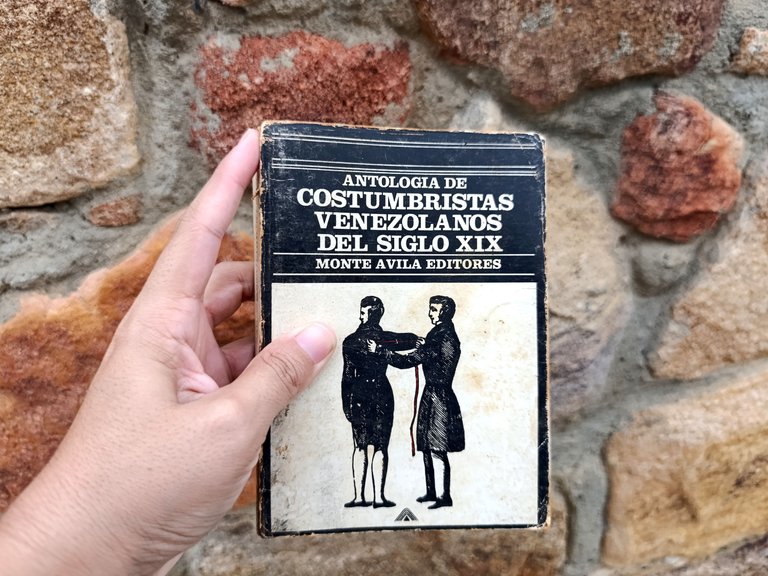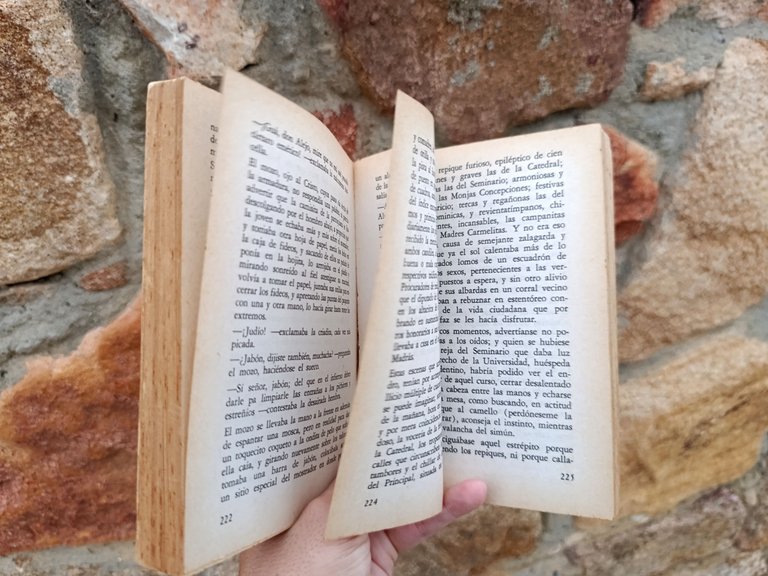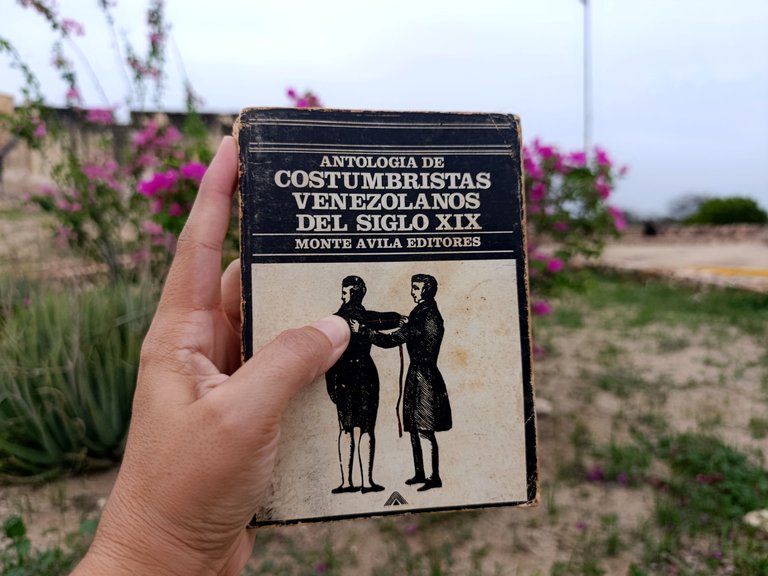In my high school, in the subject of Spanish and Literature, I researched about Costumbrismo and, in addition, I read stories and fragments of some novels. Now, I find myself with the Anthology of Venezuelan Costumbristas of the XIX Century, this work contains authors and stories that allow us to investigate the daily life of a country that sought to define its own identity.
Humor, social criticism and nostalgia for the colonial period are present in each story. Each scenario is a glimpse into the past, where the anecdote is a priority in the narrative and there are no philosophical or reflective pretensions. Among the stories that stand out, in my opinion, are El Caraqueño shopkeeper by Eugenio Méndez Mendoza, Visiting, written by Miguel Mármol and The Faun's conspiracy by Pedro Emilio Coll.

- The Caracas shopkeeper by Eugenio Méndez Mendoza
In 19th century Caracas, a cloth salesman is presented as an unscrupulous person, capable of using any dishonest practice such as lies, flattery and deceitful offers to close a deal. This skill and the dynamics of doing business in that society represent an unofficial portrait of the interactions between citizens from a mercantile perspective.
The author shows us a reality where the accumulation of money is synonymous with success in life and, therefore, the absence of honesty is justified. It is then noticed that the "viveza criolla", a characteristic that usually identifies the Venezuelan people, was already present in the coexistence of that time, so that cunning and deceit have been part of everyday life for more than a century.

- Visiting by Miguel Mármol
Also in this story the social dynamics come to light, but this time focused from the particular. A family visit is the excuse to expose the two faces of a meeting, what is talked about and what is kept quiet. The author, through irony, inference and other semantic resources, structures a discourse that clearly refers to the appearances and prejudices of Venezuelan society.
The characters show a face at the family reunion, which is expected as it is a social convention, while internally they contradict themselves and expose their conflicts to the reader, with the intention of seeking complicity and approval. Humor spices up this story where the anecdotal is privileged over the narrative.

- The Faun's Conspiracy by Pedro Emilio Coll
This story belongs to one of the masters of Costumbrismo and one of the most outstanding Venezuelan storytellers. The story takes place in the Plaza de San Juan in Caracas, where a statue of a faun is erected. From here on, that image is the center of attention, a daring proposal since it builds an atmosphere of modesty and mystery in a society more concerned with political vicissitudes than with the existence of the fantastic.
Although at the time this story did not raise controversy, because at that time reading was an activity reserved for the privileged few, it was later noted that this story arranged its elements in such a way as to project a social criticism of the rulers of the time. Of course, the militaristic government system would immediately censure this proposal, and even its author would be condemned, but by using the metaphor of a faun that stands as a symbol of resistance, the authorities did not understand the allegory, leaving this literary conspiracy for posterity.
Returning to these authors led me to a revision of history, to know through literature the customs and traditions of the Venezuelans of that time. A reminder of the value of the trends or aesthetic proposals presented, which are inexorably influenced by the social, economic and political context.
Versión en EspañolEn mi paso por el bachillerato, en la asignatura de Castellano y Literatura, investigué sobre el Costumbrismo y, además, me leí cuentos y fragmentos de algunas novelas. Ahora, me reencuentro con la Antología de Costumbristas Venezolanos del Siglo XIX, esta obra contiene autores y relatos que nos permiten indagar en la cotidianidad de un país que buscaba definir su propia identidad.
El humor, la crítica social y la nostalgia por el período colonial se asoman en cada relato. Cada escenario constituye una mirada hacia el pasado, donde la anécdota es prioridad en la narración y además no se advierten pretensiones filosóficas ni reflexivas. Entre los cuentos que destacan, según mi criterio, se encuentran El tendero caraqueño de Eugenio Méndez Mendoza, De visita, escrito por Miguel Mármol y La conspiración del Fauno de Pedro Emilio Coll.

- El tendero caraqueño de Eugenio Méndez Mendoza
En la Caracas del siglo XIX, un vendedor de telas es presentado como una persona sin escrúpulos, capaz de utilizar cualquier práctica deshonesta tales como la mentira, el halago y la oferta engañosa, para cerrar un trato. Esta habilidad y la dinámica de hacer negocios en aquella sociedad representan un retrato no oficial de las interacciones entre ciudadanos desde una perspectiva mercantil.
El autor nos muestra una realidad donde la acumulación de dinero es sinónimo de éxito en la vida y, por lo tanto, se justifica la ausencia de honestidad. Se advierte entonces que la "viveza criolla", característica que suele identificar al gentilicio venezolano, ya estaba presente en la convivencia de aquella época, así que la astucia y el engaño han formado parte de lo cotidiano desde hace más de un siglo.

- De visita de Miguel Mármol
También en este relato sale a relucir la dinámica social, pero en esta vez focalizada desde lo particular. Una visita familiar es la excusa para exponer los dos rostros de una reunión, lo que se habla y lo que se calla. El autor, a través de la ironía, la inferencia y otros recursos semánticos, estructura un discurso que claramente se refiere a las apariencias y prejuicios de la sociedad venezolana.
Los personajes exhiben un rostro en la reunión familiar, lo que se espera al ser una convención social, mientras internamente se contradicen y exponen sus conflictos ante el lector, con la intención de buscar la complicidad y la aprobación. El humor adereza esta historia donde se privilegia lo anecdótico sobre la narración.

- La conspiración del Fauno de Pedro Emilio Coll
Este cuento pertenece a uno de los maestros del Costumbrismo y uno de los más destacados cuentistas venezolanos. La historia nos ubica en la Plaza de San Juan en Caracas, donde se erige una estatua de un fauno. A partir de aquí, aquella imagen es el centro de atención, una propuesta atrevida puesto que construye una atmósfera de pudor y misterio en una sociedad más preocupada por los avatares políticos que en la existencia de lo fantástico.
Si bien en su momento este relato no levantó polémicas, debido a que en ese tiempo la lectura era una actividad reservada para algunos privilegiados, posteriormente se advierte que esta historia dispone sus elementos a manera de que proyecten una crítica social hacia los gobernantes de aquel entonces. Por supuesto que el sistema de gobierno militarista censuraría esta propuesta de inmediato, y hasta su autor sería condenado, pero al valerse de la metáfora de un fauno que se erige como símbolo de resistencia, las autoridades no comprendieron la alegoría, dejando esta conspiración literaria para la posteridad.
Volver a estos autores me llevó a una revision de la historia, conocer a través de la literatura las costumbres y tradiciones de los venezolanos de aquel entonces. Un recordatorio del valor las tendencias o propuestas estéticas presentadas, las cuales inexorablemente están influenciadas por el contexto social, económico y político.
✓Photos from my personal gallery, edited with Fotocollage.
✓Text translated with DeepL.
💫🌟💫🌟✨💫🌟💫✨🌟💫✨
✓Fotos de mi galería personal, editadas con Fotocollage.
✓Texto traducido con DeepL.
Posted Using INLEO